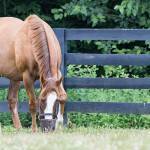Four Research-Based Tips for Feeding Horses with EMS

Two main goals of feeding horses with equine metabolic syndrome (EMS) are weight management and lowering the amount of nonstructural carbohydrates—easily digestible sugars—to minimize the body’s insulin response to meals.
“Horses with EMS typically are overweight, resistant to the normal effects of insulin to control blood sugar levels, and at risk of developing laminitis,” explained Kathleen Crandell, Ph.D., a nutritionist for Kentucky Equine Research.
According to a recently published article on EMS*, horse owners should consider these four factors when devising a diet for a horse diagnosed with EMS:
Offer hay with less than 10-12% nonstructural carbohydrates (NSC). How do you determine the NSC content of hay? By having it analyzed at a reputable commercial laboratory. Based on the results of the analysis, recommendations regarding hay soaking and ration balancers can be made. Consult your local extension specialist for information on where to send hay for analysis.
Avoid pasture intake. It’s all too easy for horses to consume excess calories when on pasture. “Horses have been known to eat up to 3% of their body weight when allowed free-choice access to pasture,” explained Crandell.
Further, many grasses are high in NSC, which could either exacerbate or induce bouts of laminitis. Use drylots and grazing muzzles to minimize intake when turned out. If this is not possible, turn out horses early in the morning when the NSC content of grass is lowest.
Activate weight management. Not all horses with EMS have excess body condition; however, the majority do fall into this category. In such cases, limit forage intake to 1.5% of their ideal body weight. For example, if your horse’s ideal body weight is 1,100 lb (500 kg), then 16.5 lb (7.5 kg) of hay with less than 10-12% NSC should be offered in a 24-hour period. No concentrates or sweet feeds should be required for horses on a weight-loss program, though a ration balancer might be appropriate.
“It is imperative to know what the horse’s current body weight is and what the ideal body weight should be to adequately perform this task. Further, owners need to actually weigh the hay to be certain the calculated amount of hay is offered rather than eyeballing or counting flakes,” Crandell advised.
If your horse fails to lose weight at this rate, hay can be decreased to 1% body weight per day, but no lower than this. Tactics designed to stretch out how long a horse eats forage can be employed, such as using haynets with small holes. Horses with inadequate forage intake are at risk of dietary imbalances, gastric ulcers, and developing stereotypies.
Add a ration balancer. A ration balancer or vitamin/mineral supplement may be indicated for horses being fed only hay.
“Kentucky Equine Research offers Micro-Max, a low-intake concentrated source of vitamins and minerals for mature horses and ponies fed diets primarily composed of forage,” noted Crandell. Look for Gold Pellet or Nutrequin in Australia.
For additional dietary information for horses and ponies diagnosed with EMS, contact a Kentucky Equine Research nutrition advisor today.
*Krzysztof Marycz, K., I. Michalakc, K. Kornicka. 2018. Advanced nutritional and stem cells approaches to prevent equine metabolic syndrome. Research in Veterinary Science 118:115-125.








